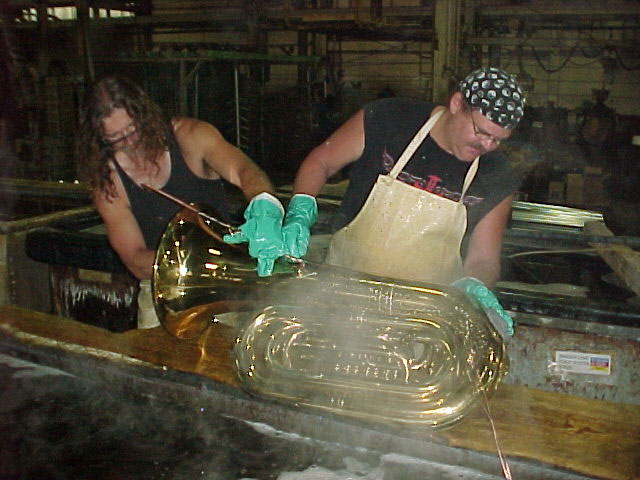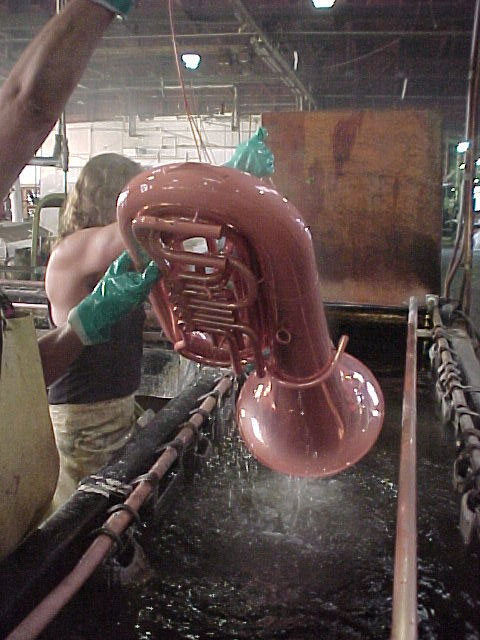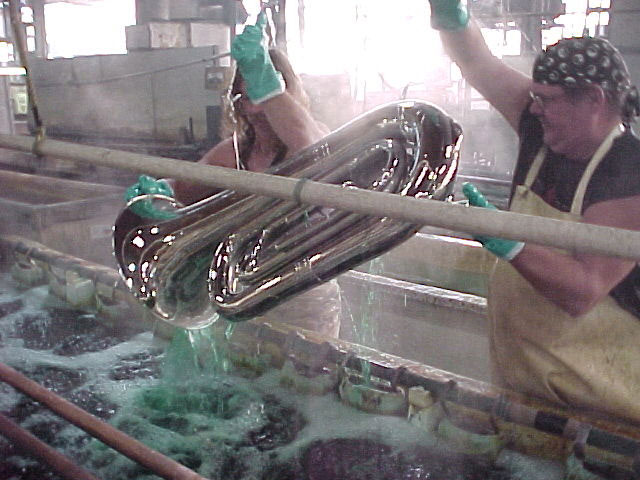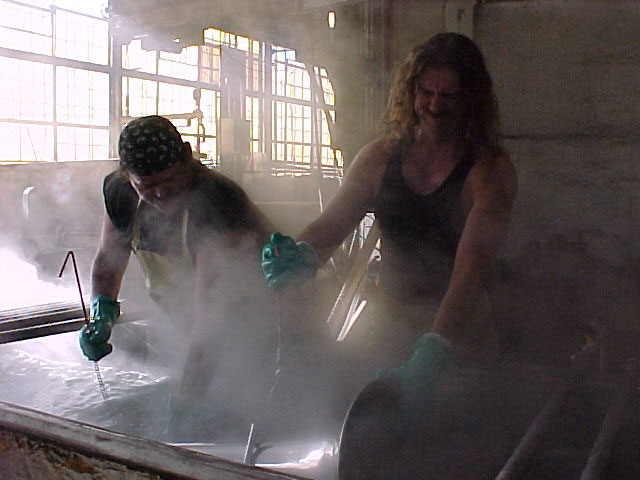Page 1 of 2
A job I will not do for you!
Posted: Tue Jul 20, 2004 8:12 pm
by Daniel C. Oberloh
I had a busy morning at the platers addressing an instrument I seldom see (thank goodness). A good friend of mine managed to catch me off guard and at a moment of mental weakness, he got me to take on an "economy overhaul" on his St. Petersburg tuba. I thought "sure why not, it couldn't be that difficult." Man did I make a big mistake! So like the title of this post says, I will not do this for you, so don't get any ideas.

I did think this would be a good oppotunity to show many of you that we don't just "dip" them and they come out nice and shiny. There is a lot involved that is not shown here, like all the dent work, polishing, soldering,etc. you can see that on my shop's web site. But at least now maybe some will have more understanding of the hard work that goes into plating large brass. I don't know of any sites showing images of tubas being plated so I thought this would be a good exercise in posting images on tubenet while at the same time giving others a chance to visualize the plating process. We electroless plated the instrument in order to get a good uniform coat of nickel. I hope you find the images interesting. Let me know your thoughts.
I apologize for the long download, I think it will be worth it! Enjoy!
Daniel C. Oberloh
Oberloh Woodwind and Brass Works
http://www.oberloh.com

Here is the tuba polished and ready to be prosessed.

Racked and ready to be cleaned in the Alkali wash.

cleaning.

More cleaning

Copper strike

Nickel strike

In to the electroless nickel bath,185 degrees F!

back at the shop and ready for assembly.
Posted: Tue Jul 20, 2004 9:29 pm
by SFAtuba
Looks great, just one question. How long did it take from start to finish??
Posted: Tue Jul 20, 2004 9:40 pm
by Daniel C. Oberloh
Copper Strike is a very this film of copper that is laid down over the entire surface of the object being plated. As a rule, I like the substrate (base metal) copper struck because it helps to achieve a brighter more even finish and will make sure that less conductive areas like solder joints will be plated as well. Because electroless nickel must be put on a nickel flash, I insisted that the flashed nickel be on copper even though it can be done on the brass itself. It is better to be safe then sorry. Yes you can copper plate and lacquer but the copper would need to be more heavy and the horn would need to be once again polished to a bright finish prior to lacquer. Though it would be nice looking, I don't think it is worth the time and effort. AKA head ache.
Daniel C. Oberloh
Posted: Tue Jul 20, 2004 9:44 pm
by Daniel C. Oberloh
Doc,
My question:Why???? Never mind.
Answer: NO

Daniel C. Oberloh
Posted: Tue Jul 20, 2004 9:47 pm
by Daniel C. Oberloh
Trevor,
We started this morning 7:15 AM and finished at 9:30AM
Daniel C. Oberloh
Posted: Wed Jul 21, 2004 5:52 pm
by Daniel C. Oberloh
The plating was replaced not because of the bad original plate, it was not really bad but because the masive amount of dent work made it necessary that we strip the plate befor performing the extensive repairs and solder work. You simply can't do good dent work on a nickel plated tuba and achive invisable repair. It also makes the job go more smoothly over the long haul with nice final results.
As for whether other types of plate plating work can be done with different metals the answer is yes but not in an electroless process and this being the case you would be hard pressed to find a shop willing to do the job. The company where I had this tuba plated is a former employer of mine and I supervised the plating (and took the pics). Three other shops in the area declined the job because of the complexity and risk involved. If you want it plated in silver, Anderson in Elkhart is the place to go, same with gold and even regular nickel and stainless nickel. I did not go with Anderson on this job because of shipping cost and the risk of damage in shipping. Remember, I am trying to make a buck here.

I don't completely agree with Bloke on the value of the tuba. Yeah it is a St.Pet and they do have a number of issues such as easy to damage bell and valves that unless corrected can be no end of trouble. But this one has a real nice tone and plays well in tune. It got smashed in transit from Europe and could not really be sold in its rather tattered condition. So, the owner knowing this decided it was better to fix it up so it could be sold even though at best, it would be a break ever sale for him as the cost of fixing the horn up is not cheap in spite of the "good buddy" discount. This all being taken into account, the tuba will get sold, the new owner will have a decent horn, I will get paid for my effort (sort of) and the original owner will have more closet space at home.

winners all around!
Daniel C. Oberloh
Oberloh Woodwind and Brass Works
http://www.oberloh.com
Posted: Wed Jul 21, 2004 10:49 pm
by Daniel C. Oberloh
To be honest, I don't have a cook-book price list on this sort of project. I deal with the big horns on a case by case basis. They really depend on the condition of the horn and to what extent the damage is to be repaired. The St. Pete job would have cost its owner about $1500 on average. similar jobs could be several hundered dollars less. I also take into considderation what some of us know as the "fun factor":D, if a job is interesting and is a chance to update ones skills the FF can keep the cost of the project down quite a bit. A customer who is a real pain in the neck:x can quickly reduce the value of the FF and find the cost of a project double in no time

Tuba repair can be costly but if the Repair person is well trained and has the skills, the costs can be kept reasonable while at the same time delivering a quality final product.
Daniel C. Oberloh
Posted: Wed Jul 21, 2004 10:58 pm
by Joe Baker
bloke wrote:Whats a Pitch Finder?
It's a main tuning slide trigger for a trumpet.
Isn't a pitch finder a self-centering trigger, with offsetting springs that return the slide to a "normal" position when it's released no matter which direction it's pushed or pulled?
_________________________
Joe Baker, who tried drawing one with ascii art, but the blanks were compressed.
Posted: Thu Jul 22, 2004 4:31 pm
by Daniel C. Oberloh
When band instruments are plated they are not plugged because of the dangers involved with trapped bubbles escaping and spraying the plater with solution in addition to causing the (in this case) tuba to float and bob in the tank. The inside of the horn does get plated to a small extent but if it
does or not is of no consern to the plater or technician. This is because the deposit of plate to the inside of the tuba is of such a small amount that it has little if any impact on how the slides and valves fit in there respective locationon. Electroless nickel can putdown a thicker amount in less time and it did in the case of the St. Pete but the inside of the horn, though very bright and shiny nickel color, still had very little in the way of plating. The reason is that the plating solution circulates in the tank replentishing the depleated solution with more nickel while the solution inside the horn is stagnant and after a short time is void of metal stopping the plating process on the inside walls of the tubing. The ends of the tuning-slide tubes do continue to receive metal but more on the outside edge then on the inside edge for the same reason. I do not know the thickness but it is good enough to stand up to a little buffing with chrome compoud and not cut through and that is good enough for me.

Daniel C. Oberloh
Oberloh Woodwind and Brass Works
http://www.oberloh.com
















